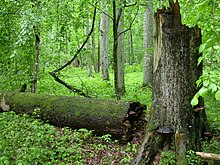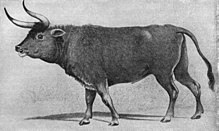Great wilderness
The Great Wilderness , as it was officially designated by the Teutonic Order , was an uninhabited and impassable landscape in the north of Eastern Central Europe in the Middle Ages . Later it became part of Masuria and Prussian-Lithuania . The Rominter Heide , now a Russian-Polish part of the 60,000 km² area, is, together with the Białowieża Primeval Forest, one of the last primeval forests in Europe.
history

When the Teutonic Order threw down the last Prussians in 1283 , a deserted area was created on the southern and eastern borders of the order area. Its repopulation lasted more than two centuries. She began with the construction of castles : 1316 Gilgenburg , 1341 Lötzen , 1345 Johannisburg , 1349 Hohenstein , 1360 Ortelsburg and 1398 Lyck . The first villages in the later Lyck district were not founded until the 15th and 16th centuries. Before the Reformation , the first settlers came from neighboring Polish Mazovia . After the Reformation, in the course of the Polish Counter-Reformation , they came as religious refugees from all over Poland , especially from the area around Krakow . The most famous of them was Johannes Maletius .
From the beginning, Germans also lived in the area, namely the ducal officials, merchants and craftsmen. In the "Willkühr" (today: main statute ) of 1670, the city of Lyck stipulated that no "non-German" was allowed to sit in the council or court of the city.
The country was ravaged by the plague four times, the last time from 1709 to 1711.
fauna and Flora

The size of the wilderness area comprised between 50,000 and 60,000 square kilometers . Due to the climatic situation, there were often severe winters. In terms of landscape, the inhospitable Great Wilderness was made up of extensive forests, swamps and rivers. Among other things, oaks , Scots pine and heather were often to be found. In addition, there were also open areas where grass-eaters could graze.
Hunting was only permitted with the approval of the Teutonic Order, and the absence of settlement and cultivation allowed the continued existence of almost all European large game species that were still in existence at the time . Roe deer , red deer , wild boar and elk lived in the great wilderness. The area was also a refuge for the last populations of large European mammals already extinct elsewhere, such as aurochs , bison and European wild horses . In addition to wolves , brown bears and northern lynxes , wolverines were also among the predators . As time went on, the wilderness became increasingly depressed and poaching increased. Aurochs were last mentioned in 1521, while the wild horse died out around the beginning of the 17th century . The last bison in the Great Wilderness was shot in 1755.
The wilderness was gradually pushed back and the landscape was visibly cultivated, the larger wild animals were thereby exterminated.
literature
- Uwe Neumärker, Volker Knopf: Görings Revier: Hunting and Politics in the Rominter Heide , 2nd edition. Berlin 2007, ISBN 978-3-86153-457-0 , digitized
- Cis van Vuure: Retracing the Aurochs - History, Morphology and Ecology of an extinct wild Ox. 2005, ISBN 954-642-235-5 .
Individual evidence
- ^ Gerd Bandilla , Lyck district community
- ↑ a b Cis van Vuure: Retracing the aurochs - History, Morphology and Ecology of an extinct wild ox. 2005, ISBN 954-642-235-5 .